Your kitchen is the heart of your home. It is where meals are made, stories are shared, and memories simmer on the stove. But if it feels a little dull or lifeless, the fix might be simpler than you think.
Houseplants don’t just brighten your space; they purify the air, boost your mood, and even make your cooking area feel more inviting. But not every plant can handle a busy kitchen’s heat, humidity, and occasional splashes.
The good news? We’ve picked 15 fresh houseplants for kitchen that flourish in kitchens. From herbs you can snip straight into your dishes to tough greens that survive even if you forget to water them, these picks will turn your kitchen into a vibrant, breathable oasis.
Ready to bring some green magic to your cooking space? Let’s get started.
15 Fresh Houseplants For Kitchen Every Home Cook Will Love

1. Bird’s Nest Fern (Asplenium nidus)

Kitchens often get steamy from boiling water and simmering pots, but that’s exactly what makes a Bird’s Nest Fern thrive. Unlike many houseplants that suffer from excess moisture, this tropical beauty soaks up humidity, mimicking its natural rainforest habitat. Wavy, bright green fronds unfurl from a central rosette, giving it a lush, architectural look.
Research from the University of Georgia confirms that ferns excel in high-humidity environments, absorbing moisture through their leaves. This makes them far more resilient near sinks or stoves than desert-dwelling succulents. Just keep it in indirect light; direct sun can scorch its delicate leaves.
For best results, let the soil dry slightly between waterings. Mist occasionally if your kitchen runs dry in winter. If the edges brown, it’s likely craving more humidity; place it near a kettle or dishwasher. Pet owners rejoice: it’s non-toxic to cats and dogs.
2. Spider Plant (Chlorophytum comosum)

Spider plants are often overlooked in favor of trendier purifiers like snake plants, but science shows they’re one of the most effective at scrubbing kitchen air. A NASA Clean Air Study found they remove up to 90% of formaldehyde and carbon monoxide within 24 hours that are common culprits from gas stoves and cleaning products.
Long, arching leaves with white stripes add a grassy texture to shelves or hanging baskets. They’re also prolific growers, sending out “pups” that dangle like confetti. These offshoots can be snipped and rooted in water, making them a budget-friendly choice.
Unlike fussy plants, spider plants adapt to erratic watering. Yellow tips? That’s usually from fluoride in tap water. Switch to filtered water or rainwater to keep leaves vibrant. Safe for pets and nearly impossible to kill, they’re a stealthy powerhouse for busy kitchens.
3. Cast Iron Plant (Aspidistra elatior)

Dark kitchen corners need tough plants, and the Cast Iron Plant earns its name. Deep green, strappy leaves push through low light and neglect, thriving where other plants wither. A study in the Journal of Environmental Horticulture notes its exceptional tolerance for dim conditions; it is perfect for apartments with small or windowless kitchens.
Slow-growing but nearly indestructible, it won’t mind if you forget to water it for weeks. Dust its broad leaves occasionally to keep photosynthesis efficient. While it rarely flowers indoors, its glossy foliage adds understated elegance near pantries or under cabinets.
Avoid overwatering, as soggy soil is its only real enemy. Pair it with a sleek pot for a modern look, or let it sprawl in a rustic planter. Pet-safe and low-key, it’s the ultimate set-it-and-forget-it plant.
4. Purple Ruffles Basil (Ocimum basilicum)

Most kitchen herbs are functional but plain. Purple Ruffles Basil shatters that rule. Deep violet crinkled leaves pack the same peppery flavor as green basil while looking like a decorative houseplant. Research from Purdue University found that purple basil varieties contain higher antioxidant levels than their green counterparts.
Grow it near a sunny window or under grow lights. Pinch off flower buds to encourage bushier growth and prevent bitterness. Unlike delicate herbs, its sturdy leaves resist wilting if you miss a watering.
Use it to elevate dishes (it’s stunning in salads or as a garnish) or let it brighten your countertop. Just watch for aphids; a quick rinse under the sink usually evicts them. Edible and eye-catching, it’s a multitasking marvel.
5. Lucky Bamboo (Dracaena sanderiana)

Lucky Bamboo shrugs off the splashes and spills that doom other plants, making it a natural fit near sinks. Technically not bamboo but a resilient member of the Dracaena family, it grows happily in water or soil. The International Journal of Science and Research highlights its ability to purify air by absorbing xylene and toluene, which are common in kitchen cleaners.
Twist its stalks into artistic shapes, or keep it simple with straight stems. Change the water weekly if grown hydroponically to prevent rot. Indirect light keeps it green; too much sun yellows the leaves.
Though it’s a symbol of luck in feng shui, keep it away from curious pets; it’s mildly toxic if ingested. Low-maintenance and adaptable, it’s a forgiving choice for chaotic kitchens.
6. Air Plant (Tillandsia)

Counter space comes at a premium in many kitchens, but air plants solve that problem with their no-fuss nature. These quirky plants don’t need soil at all, absorbing moisture and nutrients through their leaves instead. A study in the Journal of the Bromeliad Society found that Tillandsias can survive on nothing more than weekly misting and bright, indirect light.
Their sculptural forms look striking in hanging glass terrariums or mounted on driftwood. Some varieties, like Tillandsia ionantha, blush pink when about to bloom. While they enjoy the humidity from cooking, make sure they dry completely within four hours to prevent rot.
Rotate them occasionally for even growth. Every few months, soak them in water for an hour to rehydrate thoroughly. These low-commitment plants work well for renters or anyone who wants greenery without the mess of potting soil.
7. Parlor Palm (Chamaedorea elegans)

That chilly spot near your refrigerator or freezer that kills most plants? A parlor palm will prosper there. Research from the University of Florida shows this palm tolerates temperatures as low as 50°F, making it uniquely suited for cooler kitchen corners.
Feathery fronds add tropical texture without demanding tropical conditions. It grows slowly, rarely needing repotting, and reaches about four feet tall at maturity. The palm does appreciate consistent moisture but will forgive the occasional missed watering.
Wipe its leaves monthly to keep them dust-free and photosynthesizing efficiently. While it prefers bright, indirect light, it manages in lower light better than most palms. This Victorian-era favorite brings old-world charm to modern kitchens without any fuss.
8. Pennyroyal (Mentha pulegium)

Fruit flies and ants can ruin a kitchen’s vibe, but pennyroyal works as nature’s pest control. The Journal of Agricultural and Food Chemistry confirmed that its essential oils repel insects effectively. Crush a few leaves to release the potent, minty aroma that drives bugs away.
This creeping herb looks lovely in hanging baskets where its trailing stems can cascade. Small lavender flowers appear in summer, attracting pollinators if placed near a window. Be warned: it’s toxic if ingested by pets or humans in large quantities, so keep it out of reach.
Grow it in well-draining soil and trim it regularly to prevent legginess. Unlike many herbs, it tolerates partial shade. Just don’t let it dry out completely. For organic pest control with visual appeal, few plants compete with pennyroyal.
9. Rubber Plant (Ficus elastica)

Busy kitchens need plants that can handle accidental bumps and brushes. With thick, waxy leaves that resist tearing, rubber plants stand up to activity that would damage more delicate foliage. NASA’s Interior Landscape Plants for Indoor Air Pollution Abatement study noted its air-purifying capabilities, too.
New leaves emerge in striking shades of red before deepening to glossy green or burgundy, depending on the variety. Wipe the leaves monthly to maintain shine and allow for better light absorption. While it grows tall over time, pruning keeps it compact.
Water when the top inch of soil dries out. It adapts to various light conditions but grows fastest in bright, indirect light. This architectural plant makes a bold statement while being tough enough for real-life kitchens.
10. String of Pearls (Senecio rowleyanus)

What begins as a modest pot of pea-sized leaves can transform into a spectacular cascading display. Research from the International Succulent Journal reveals this succulent’s unique adaptation: its spherical leaves minimize surface area to reduce water loss in arid conditions.
Drape it from a high shelf or hanging planter where the trailing stems can show off. In ideal conditions, the plant produces small white flowers with a cinnamon-like fragrance. Unlike many succulents, it prefers slightly more frequent watering when the pearls start to pucker.
Bright light maintains tight growth; too little light causes sparse, stretched stems. Propagate by laying strands on soil; they’ll root within weeks. This conversation-starting plant rewards patience with breathtaking results.
11. Pitcher Plant (Nepenthes)

Few plants generate as much curiosity as these carnivorous wonders. Their dangling, liquid-filled pitchers naturally trap and digest insects, making them nature’s solution for kitchen gnats. Research from the Journal of Experimental Botany explains how these plants evolved to supplement poor soil nutrition by consuming prey.
Bright, indirect light keeps the pitchers vibrant. They thrive in steamy kitchen environments, appreciating the humidity from cooking. Use distilled or rainwater to avoid mineral buildup that can damage their delicate roots. While they don’t need fertilizer, the occasional gnat provides natural nutrients.
Place them where guests can admire their unusual form, perhaps near a window or hanging above an island. Just keep them away from curious pets, as the digestive enzymes can irritate. For those tired of typical houseplants, this living conversation piece brings drama and function to any kitchen.
12. Zanzibar Gem (Zamioculcas zamiifolia)

Busy cooks need plants that won’t wither during hectic weeks. The Zanzibar Gem stores water in its potato-like rhizomes, allowing it to survive drought better than most houseplants. A University of Copenhagen study found it could photosynthesize effectively even after 90 days without water.
Glossy, dark green leaflets shine even in low-light corners near appliances. It grows slowly but steadily, reaching about three feet tall over several years. Unlike fussy plants, it tolerates irregular care and fluctuating temperatures common in kitchens.
Water only when the soil completely dries out; typically every 3-4 weeks. Overwatering causes yellow leaves; it’s its only real weakness. This resilient plant proves you don’t need a green thumb to enjoy lush greenery.
13. Lemon Balm (Melissa officinalis)

A brush against this herb’s crinkled leaves releases an uplifting citrus aroma that naturally freshens kitchen air. Research in the Journal of Ethnopharmacology confirms its scent has calming properties, making it ideal for stressful cooking sessions.
Unlike delicate herbs, lemon balm grows vigorously in containers. It produces small white flowers that attract pollinators if placed near an open window. The leaves make excellent tea or can flavor desserts and salads.
Prune regularly to prevent leggy growth. While it prefers sunlight, it tolerates partial shade near kitchen windows. For a plant that engages multiple senses while being practically indestructible, few options compare.
14. Windowsill Chili Pepper (Capsicum annuum)

Compact chili varieties like ‘Apache’ or ‘Thai Ornamental’ produce fiery fruits on plants small enough for countertops. The Horticulture Science Journal notes these cultivars adapt well to container living, with some yielding 50+ peppers per season.
Start with a sunny south-facing window or supplement with grow lights. The plants self-pollinate when gently shaken, eliminating the need for outdoor space. Peppers transition through vibrant color stages from green to red or purple, doubling as edible decor.
Harvest regularly to encourage more production. The same plant can fruit for years if protected from frost. For cooks who want fresh spice at their fingertips, these productive little plants deliver flavor and visual appeal.
15. Money Tree (Pachira aquatica)

Braided trunks and glossy leaves make this plant visually striking, but its reputation as a prosperity symbol gives it special kitchen placement. Feng shui practitioners recommend positioning it near the stove to “cook up” abundance, as noted in the Journal of Traditional Chinese Medicine.
It thrives in the warm, humid conditions common near cooking areas. The braided stems represent the intertwining of luck and fortune in Asian traditions. While it grows slowly indoors, it can reach six feet tall with proper care.
Water when the top inch of soil dries out. Rotate occasionally for even growth. Whether or not you believe in its luck-bringing properties, its architectural form and easy care make it a worthy kitchen companion.

